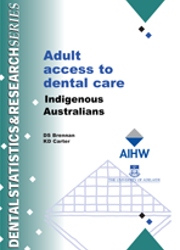Summary
This report examines oral health and access issues relating to Indigenous Australian adults. Findings at the population level are presented from the series of National Dental Telephone Interview Surveys conducted in 1994, 1995 and 1996. These data include both adults who have a government concession card (who may be eligible for public-funded dental care), and those who do not. The findings are not restricted by time since last dental visit, and include adults who have not made a recent dental visit. Population estimates are presented on oral health status, access to services, and on social impact and economic factors.
Also presented are findings related to patients receiving public-funded dental care. These data were obtained from the Prospective Adult Dental Programs Survey in 1995-96.
Public-funded dental care may include care provided at public dental clinics as well as care provided by private practitioners to eligible patients that is paid for by public funds. Estimates are presented on the type of care received, oral health status, and services provided.
The findings are based on national surveys but the number of Indigenous persons is small. Few older Indigenous persons were surveyed, resulting in a young age distribution of Indigenous persons. However, despite these limitations, the findings highlight the lack of information available on this important health issue, and may stimulate interest and debate on the topic, and serve to provide impetus for further research to improve our knowledge - and to assist in the process of planning and developing of policy to improve health status.
Population
Indigenous Australians experienced a higher rate of edentulism (i.e. complete tooth loss) than non-Indigenous Australians (27.8% cf. 14.1% among 45-64-year-olds, and 16.3% cf. 10.7% overall). When controlling for age group, the percentage of dentate persons (i.e. those having some natural teeth) who wore a denture was higher among Indigenous than non- Indigenous persons (e.g. 17.8% cf. 9.7% among 25-44-year-olds).
There were no discernible differences in the time since last dental visit by Indigenous status among dentate adults; however, a much higher percentage of Indigenous adults whose most recent dental visit was less than 12 months ago last visited for a dental problem (77.1% cf. 55.8%). Dentate Indigenous adults were also more likely than non -Indigenous adults to have reported a problem as their usual reason for a dental visit (63.7% cf. 49.7%). Among dentate adults, Indigenous compared to non-Indigenous Australians had made a lower mean number of dental visits (1.81 cf. 2.43 visits), and had received a lower number of fillings (0.42 cf. 0.98 fillings), but the same mean number of extractions, in the previous 12 months.
A higher percentage of dentate Indigenous adults reported experience of toothache in the previous 12 months compared to non-Indigenous adults (16.1% cf. 12.0%). Indigenous adults were less likely than non-Indigenous adults to have private dental insurance (28.2% cf. 39.2%), and were more likely to report 'a lot of difficulty in paying a $100 dental bill' than non -Indigenous adults (33.5% cf. 14.1%).
Across the population indicators presented, Indigenous Australians were found to generally have less favourable results than non-Indigenous Australians. On no indicator were Indigenous adults found to have a substantial advantage. Indigenous Australians had poorer oral health outcomes (i.e. higher edentulism and denture use), and were more likely to: visit for a dental problem, have fewer dental visits, experience more toothache, not be insured, and report a lot of difficulty in paying a $100 dental bill.
Public-funded dental patients
The percentage of adults receiving emergency care was similar for Indigenous and non -Indigenous patients (51.7% cf. 57.3%). However, there were some differences in oral health status, with lower percentages of edentulism among Indigenous patients (3.2% cf. 8.3%). Among dentate adults, Indigenous patients had a higher percentage with periodontal pockets of 6+ mm (25.4% cf. 11.6%) and higher numbers of decayed teeth (3.56 cf. 1.94), but lower overall caries experience (10.47 cf. 13.91 decayed, missing and filled teeth), lower numbers of missing teeth (3.09 cf. 5.34) and filled teeth (3.81 cf. 6.62), and lower root caries experience (0.37 cf. 0.69 decayed and filled roots).
To control for potential confounding factors, multiple logistic regressions of services received were performed by Indigenous status, controlling for age, type of care, country of birth, language spoken, geographic location, numbers of decayed and missing teeth, numbers of decayed roots, and the presence of periodontal pockets. Differences in service provision by Indigenous status persisted in the area of extractions after controlling for these other factors. Compared to the reference category of non -Indigenous patients, Indigenous patients had higher odds of extraction services (odds ratio, 3.40; 95% confidence interval = 2.02-5.73).
The higher odds of receiving extraction services points to less favourable service provision outcomes for Indigenous patients.



